Isaac Hale’s Research
Peer-Reviewed Publications
Relationship Between Racial Attitudes & Political Participation Index Across Samples

Race, Partisanship, and Democratic Politics: The Role of Racial
Attitudes in Motivating White Americans’ Electoral Participation
with Carlos Algara, Assistant
Professor of Political Science, Claremont Graduate University
\(\star\) Manuscript Published in the Journal of Race, Ethnicity, and Politics (2023) \(\star\) Manuscript Data Materials
Abstract: While there is considerable research on
the role racial attitudes play in shaping white political preferences,
relatively little is known about how racial attitudes influence white
participation in democratic politics. We present a model examining the
relationship between racial attitudes and political participation in the
2016, 2018, and 2020 U.S. national elections. Using a variety of
measures of political participation, our analysis presents a clear
finding: the direction of the relationship between latent conservative
racial attitudes and political participation is asymmetrical among
partisan sub-groups, with conservative racial attitudes motivating
participation among white Republicans and, to a greater degree,
depressing participation among white Democrats. This finding has stark
implications for how racialized appeals are likely to be deployed in an
era of increasing affective partisan polarization.
Predicted Probability of NDP Vote by Minority Feeling Thermometer and Time Period, 95% confidence intervals

Racial Attitudes and Vote Choice in National Canadian
Elections
\(\star\) Manuscript Published in the Canadian Journal of Political Science (2023) \(\star\) Manuscript Data Materials
Abstract: This article examines the effect of racial
attitudes on the electoral performance of the New Democratic Party
(NDP). Since 2017, the NDP has been led by Jagmeet Singh, the first
non-white leader of a nationally competitive Canadian political party.
Voters’ racial attitudes and the race of party leaders have a
significant effect on vote choice in the United States. Less is known
about whether similar effects exist in Canadian elections. I show that
NDP vote choice polarized on the basis of racial attitudes following
Singh’s ascension to party leader. Voters with cold feelings toward
racial minorities were less likely to vote for the NDP in 2019 and 2021
than in comparable historical elections. In contrast, there is no
significant difference between 2019/2021 and prior elections in support
for the Liberals and Conservatives among such voters. These results
suggest that racial attitudes are salient in Canadian elections and that
national parties may face an electoral penalty when selecting non-white
party leaders.
Cumulative Pre-election COVID-19 Deaths, by County
Nail in the Coffin or Lifeline? Evaluating the Electoral Impact of
COVID-19 on President Trump in the 2020 Election
with
Carlos Algara, Assistant
Professor of Political Science, Claremont Graduate University
Sharif Amlani, PhD
candidate, Political Science, University of California, Davis
Samuel
Collitt , Researcher, Committee of 100
&
Sara Kazemian, PhD
candidate, Political Science, University of California, Davis
\(\star\) Manuscript Published in Political Behavior (2022) \(\star\) Manuscript Data Materials
Abstract: From the onset of the first confirmed case
of COVID-19 in January 2020 to Election Day in November, the United
States experienced over 9,400,000 cases and 232,000 deaths. This crisis
largely defined the campaign between former Vice President Joe Biden and
President Donald Trump, centering on the Trump administration′s efforts
in mitigating the number of cases and deaths. While conventional wisdom
suggested that Trump and his party would lose support due to the
severity of COVID-19 across the country, such an effect is hotly debated
empirically and theoretically. In this research, we evaluate the extent
to which the severity of the COVID-19 pandemic influenced support for
President Trump in the 2020 election. Across differing modeling
strategies and a variety of data sources, we find evidence that
President Trump gained support in counties with higher COVID-19 deaths.
We provide an explanation for this finding by showing that voters
concerned about the economic impacts of pandemic-related restrictions on
activity were more likely to support Trump and that local COVID-19
severity was predictive of these economic concerns. While COVID-19
likely contributed to Trump’s loss in 2020, our analysis demonstrates
that he gained support among voters in localities worst affected by the
pandemic.
Strength of Partisanship in Direct-Elections for U.S. Senate, 1914-2020
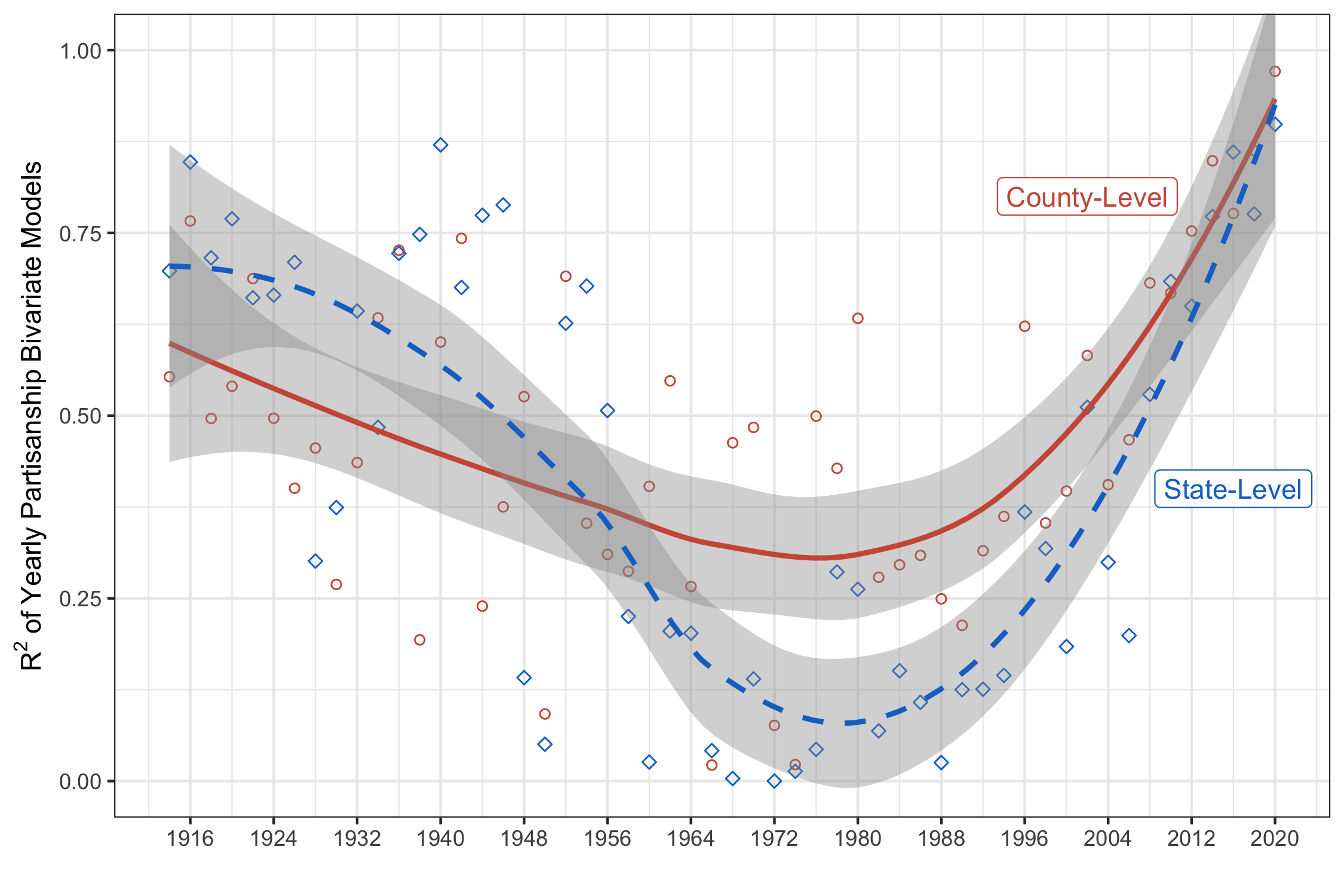
Do Voters Balance Partisan Control of the Federal Government During
the Partisan Era? Assessing the Case of the 2021 Georgia U.S. Senate
Runoffs
with Carlos Algara,
Assistant Professor of Political Science, Claremont Graduate University
& Cory
Struthers, Assistant Professor of Public Administration and Policy,
University of Georgia
\(\star\) Manuscript Published in American Politics Research (2022) \(\star\)Manuscript Data Materials
Abstract: Recent work on American presidential
election cycles posits that voters engage in anticipatory balancing,
with voters being more likely to vote against a legislative candidate if
they believe the candidate’s party will win the presidency. This theory
predicts split-ticket voting on the basis that voters prefer divided
government to moderate collective policy outcomes by forcing agreement
among institutions controlled by opposing parties. We test this theory
within the context of the 2021 Georgia U.S. Senate runoffs, which solely
determined whether Democrats would have unified control of the federal
government by determining majority control of the Senate. This context
provides a crucial test of the theory by providing an environment of
perfect information in which partisan control of the presidency and the
House of Representatives is already determined and not conditional on
standing election outcomes across states. Leveraging an original survey
of Georgia voters, we find no evidence of balancing within the general
electorate and among partisans across differing model specifications. We
confirm this lack of balancing in qualitative content analysis of voter
electoral runoff intentions. We reconcile this lack of evidence for
balancing to original analysis showing the unprecedented partisan nature
of contemporary Senate elections since direct-election began in
1914.
The Chilean Party System in the Electorate, 1989-2017
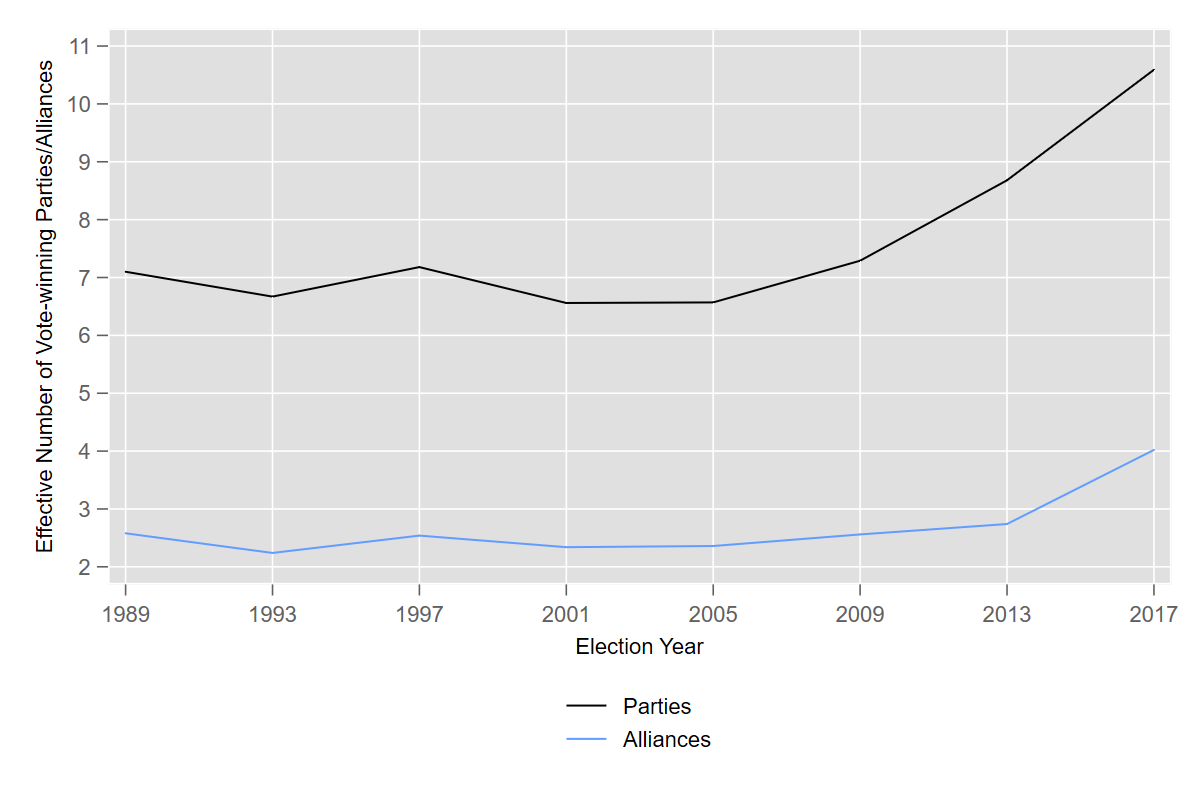
Electoral Reform & Strategic Voting in Chilean Legislative Elections
\(\star\) Manuscript Published in Representation (2021) \(\star\)Manuscript Data Materials
Abstract: This paper examines the effects of Chile’s
2015 electoral reform, which increased the magnitude of districts in
Chile’s lower legislative chamber from two to between three and eight.
This increase in district magnitude allows for a convenient “natural
experiment”: post-reform voters should strategically vote at lower
levels than pre-reform voters. I find strong evidence that voters have
responded to Chile’s electoral reform by engaging in less party-level
strategic voting. However, I surprisingly find no evidence that the
reform has decreased strategic voting for Chile’s pre-electoral pacts.
This study demonstrates that Chile’s electoral reform is already
affecting voter behavior and is doing so in line with theoretical
expectations.
Bivariate Relationship between Subnational Racial Resentment & GOP Vote Shares
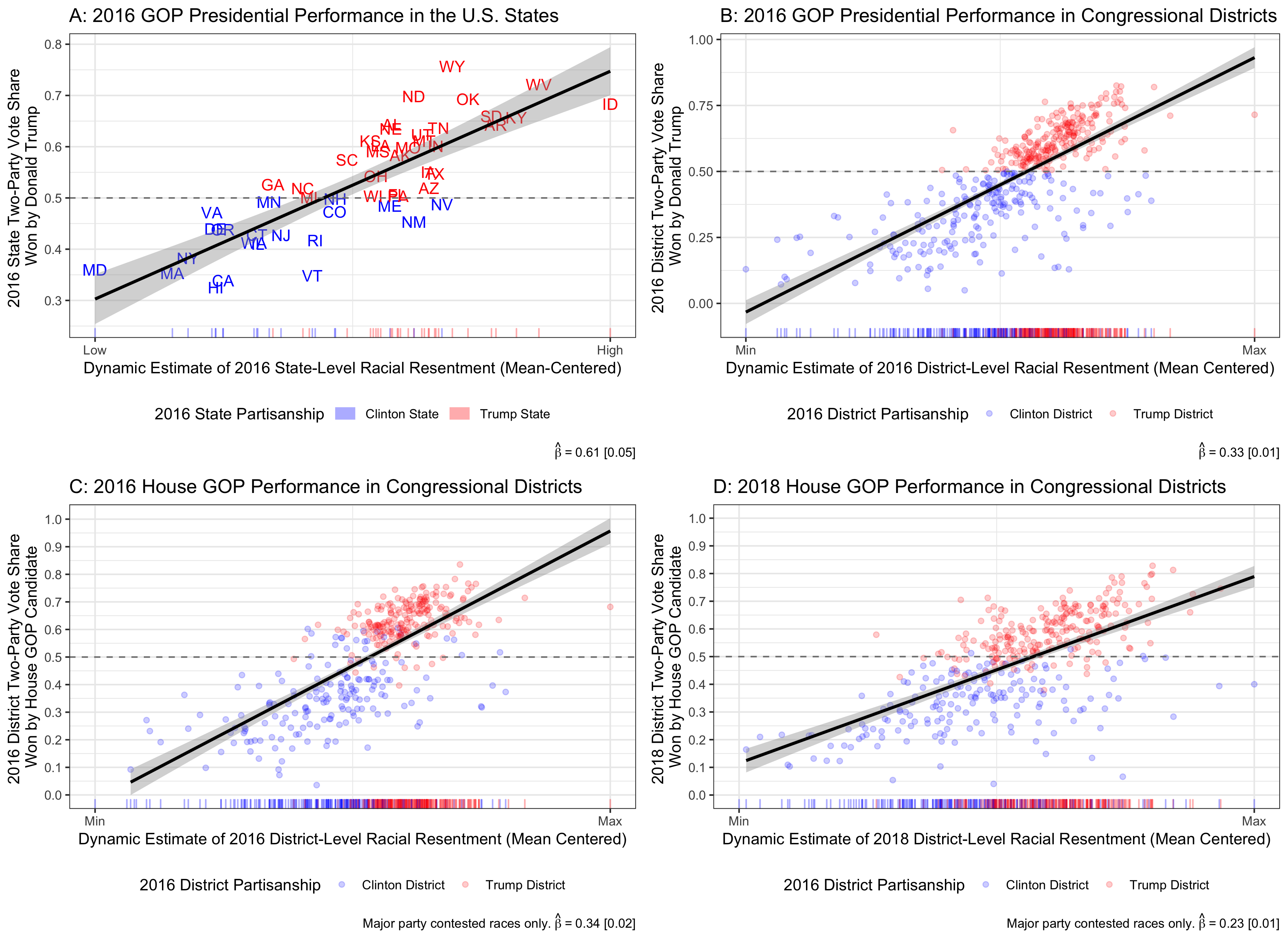
Racial attitudes & political cross-pressures in nationalized
elections: The case of the Republican coalition in the Trump era
with Carlos Algara, Assistant
Professor of Political Science, Claremont Graduate University
\(\star\) Manuscript Published in Electoral Studies (2020) \(\star\)Manuscript Data Materials
\(\star\)Research featured in The New York Times, The Texas Tribune, The Sacramento Bee, Roll Call, La Croix, and APSA’s RAISE the Vote blog.
Abstract: While scholars have found that Trump was able to capitalize on the racial attitudes of white voters, it is less clear how these racial attitudes influenced vote-choice across partisan and ideological cleavages in the electorate. It is also unclear whether racial attitudes affected voting at the congressional level or electoral outcomes at the aggregate level. Using a novel measure of racial attitudes at the subnational level and survey data, we make three clear findings: (1) Trump and Republican congressional candidates benefited from conservative racial attitudes both at the aggregate level and among white voters, (2) this electoral benefit for Republicans persisted during the 2018 midterm elections, and (3) the effect of attitudes on vote-choice did not significantly vary across partisan and ideological cleavages in the white electorate. Our findings suggest that, even during the era of highly nationalized and partisan elections, racial attitudes are still a mechanism by which Republicans can win significant electoral support among Democrats and relatively liberal voters in the white electorate. These findings have implications for the growing salience of race in the Republican electoral coalition.
Scatterplot of Re-scaled Bonica CFscores Against Shor-McCary NPAT Scores for State Legislators
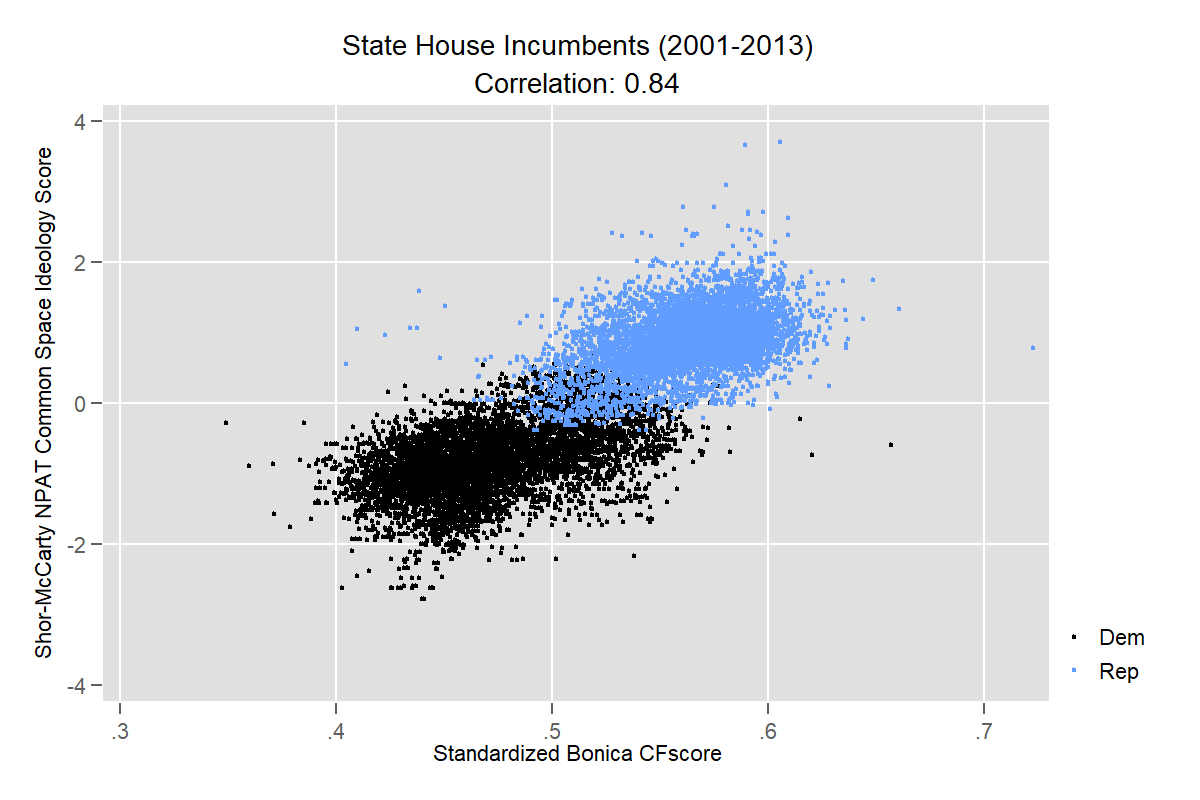
Candidate Extremism and Electoral Design in U.S. State Legislative Elections
\(\star\)Manuscript Published in Social Science Quarterly (2019) \(\star\)Manuscript Data Materials
Abstract: This study examines the effect of electoral system variation in U.S. state legislative elections on candidate ideological dispersion. Previous work suggests that, under certain conditions, greater district magnitude has a centrifugal polarizing effect on candidate ideology. Cross-national investigations of this theory by Ezrow (2008) and Dow (2001, 2011) have produced conflicting results. Building on this body of research, this paper leverages electoral system variation in U.S. state legislative elections to evaluate whether district-level electoral system variation influences candidate ideology. We find strong evidence for a polarizing effect of district magnitude on candidate ideology, even under plurality voting. This paper has significant implications for our understanding of candidate ideological positioning in sub-national contexts as well of how electoral systems affect the quality of representation voters receive from legislators.
Predicting Strategic Vote With Perceptions of Candidate Viability
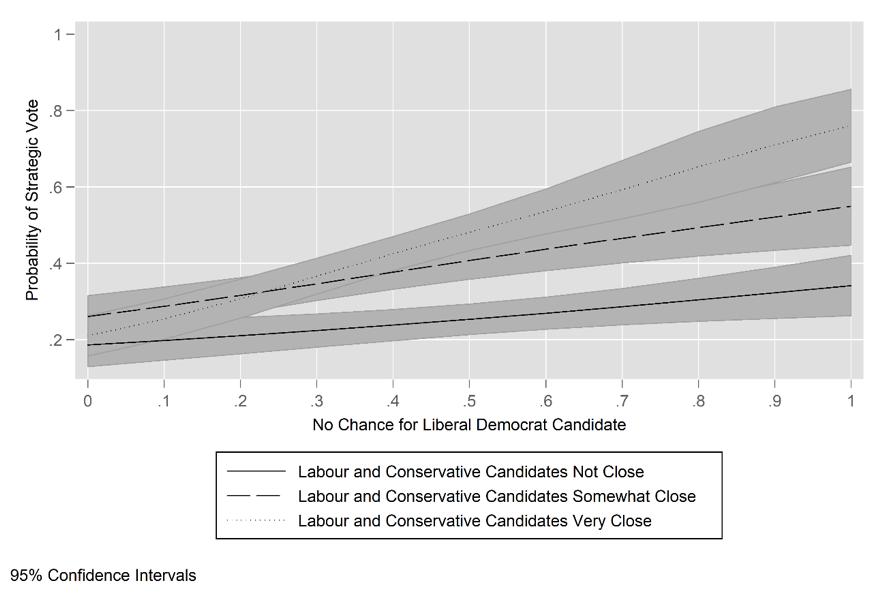
Abandon Ship? An Analysis of Strategic Voting among Liberal Democrat Voters in the 2015 UK Election
\(\star\)Manuscript Published in Parliamentary Affairs (2019) \(\star\)Manuscript Data Materials
\(\star\)Research featured in the London School of Economics’ Democratic Audit blog.
Abstract: Strategic voting occurs when voters make vote choices using their ex ante expectations about the results of an election in addition to their sincere candidate preferences. While there is ample theoretical reason to believe strategic voting should occur under certain electoral conditions and institutional arrangements, the evidence for it in the literature has been mixed. I theorise that the polarisation of the two main British political parties and the highly publicised predictions of defeat for Britain’s primary national third party, the Liberal Democrats, make the 2015 UK election an ideal case for studying strategic voting. I adapt established methods of identifying strategic voting to this election and find evidence that Liberal Democrat voters in the UK voted strategically for Labour and Conservative candidates to maximise their odds of affecting the electoral outcome in their constituency.
Probability of Democratic House Vote by Racial Resentment and Candidate Race Among Whites

The Compound Effects of Candidate Race and Racial Resentment in US House Elections
\(\star\)Manuscript Published in the Journal of Race, Ethnicity, and Politics (2019) \(\star\)Manuscript Data Materials
Abstract: Despite the longstanding underrepresentation of blacks in Congress, political science research has not settled on the cause. While there is increasing evidence that racial attitudes affect vote choice in today’s congressional elections, how this effect interacts with the race of the candidates is unknown. This study addresses this debate by analyzing novel survey, census, and candidate data from the Obama era of congressional elections (2010-2016) in order to test whether racially prejudiced attitudes held by whites decrease their likelihood of supporting black Democratic candidates and Democratic candidates as a whole. In line with theoretical predictions, this paper finds that Democratic House candidates are less likely to receive votes among white voters with strong racial resentment towards blacks, and black Democratic candidates fare even worse. These findings provide an explanation for black legislative underrepresentation and contribute to theories of partisan racial realignment.
Distribution of 2016 Federal Election Candidate Positions
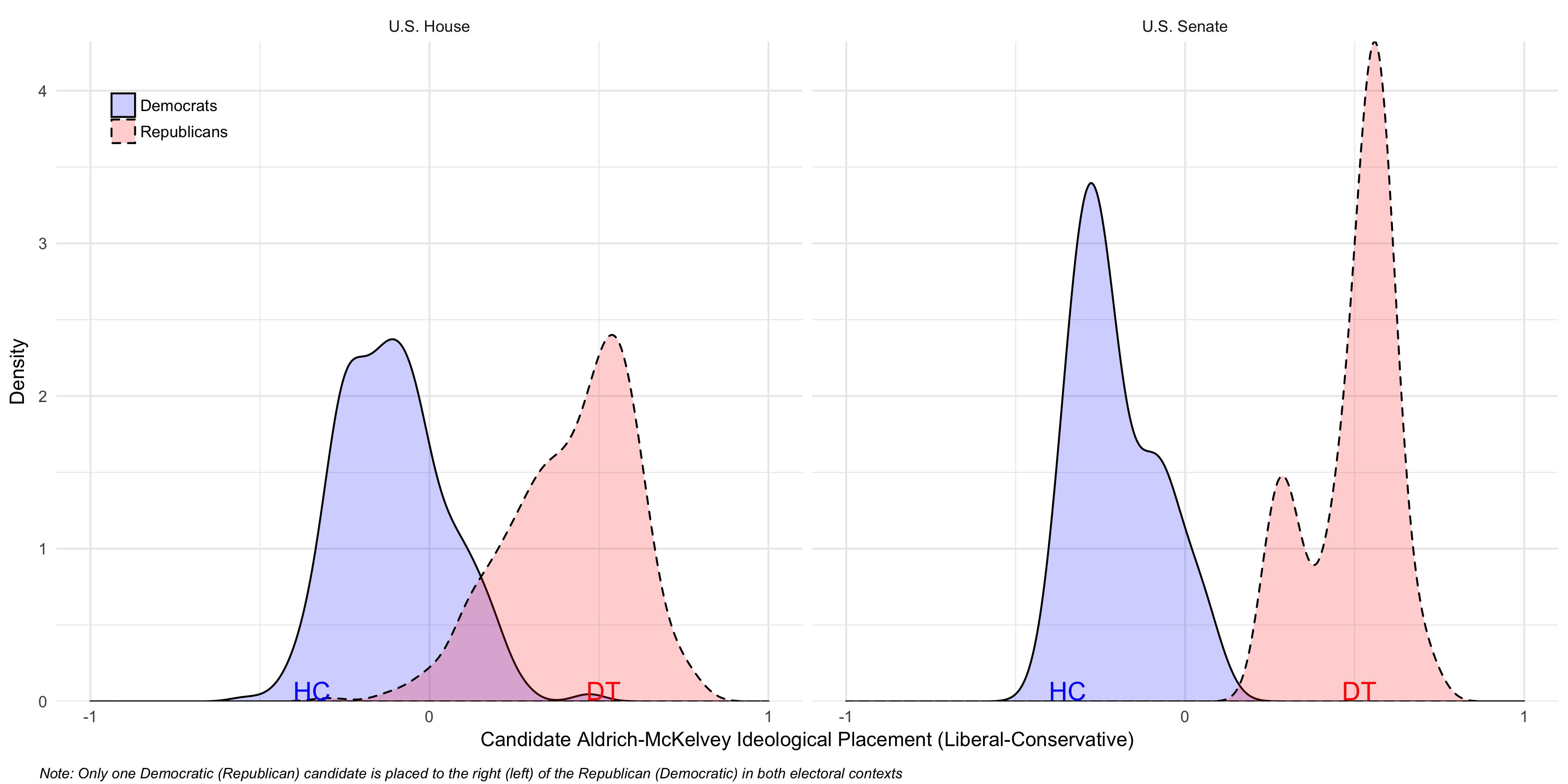
The Distorting Effects of Racial Animus on Proximity Voting in the
2016 Elections
with Carlos
Algara, Assistant Professor of Political Science, Claremont Graduate
University
\(\star\)Manuscript Published in Electoral Studies (2019) \(\star\)Manuscript Data Materials
\(\star\)Research featured in The New York Times, Pacific Standard, and La Tercera.
Abstract: While the use of racial appeals by the
2016 Trump campaign is indisputable, researchers are actively debating
their precise role in influencing voter behavior in the election. We
seek to expand upon existing research which finds that racial animus
electorally benefited the Trump campaign. We examine to what extent
those benefits redounded to GOP candidates down-ballot and whether
racial animus distorted ideological proximity voting in the 2016
election. We find that racial animus among voters helped Republicans at
multiple ballot levels and that higher levels of racial animus distorted
correct proximity voting among voters ideologically closest to the
Democratic candidate. Our findings suggest that high salience campaign
appeals on race at the presidential level can influence elections for
the House and Senate. We also provide evidence that the process of
racial partisan realignment is incomplete, as some white voters still
vote incongruously with their ideology due to racial animus.
California Top-2 Election Competitiveness by Party Registration and Election Type
Some General Consequences of California’s Top-Two Primary System
with Benjamin
Highton, Professor of Political Science, University of California,
Davis
& Robert
Huckfeldt, Distinguished Professor of Political Science, University
of California, Davis
\(\star\)Manuscript Published in the California Journal of Politics and Policy (2016) \(\star\)Manuscript Data Materials
Abstract: This paper analyzes some of the general election consequences of the top-two primary system in California elections beginning in 2012. In particular we focus on general election contests between candidates of the same party that were not possible under the previous primary system, but have occurred with some regularity with the top-two.We find that same party elections are characterized by greater competitiveness, lower turnout, and less, but still substantial, polarized voting.
Copyright © 2019-2024 by Isaac Hale. Made with RStudio.